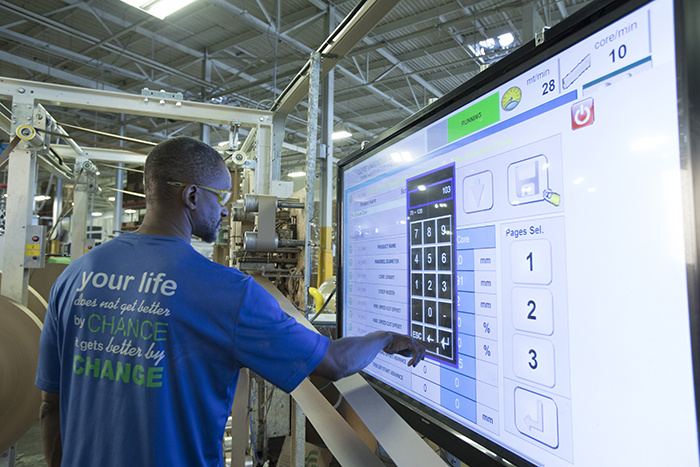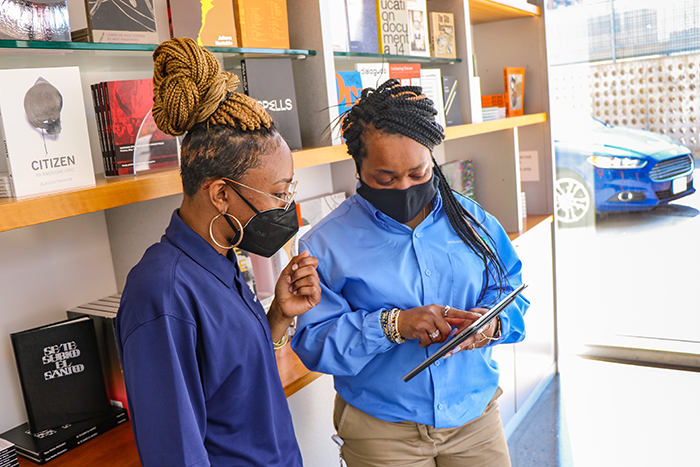Who are the employees in your organization? What are their unique perspectives and life experiences? If your company tends to hire people from a similar background you may not be getting the variety of viewpoints you need for your business to thrive and your staff to flourish.
The building services and cleaning industry is recognizing the value of a diverse workforce. Learn what building service providers, manufacturers, distributors, and other sectors of the industry are doing to attract women, minorities, and people with disabilities to their companies and promote them from within. Discover how these workers are bringing a fresh outlook to the industry and positioning companies to compete in a more equitable, global society.
Bringing women back to work
When schools and daycares closed at the beginning of the coronavirus pandemic, many women were forced to quit their jobs to care for their children and help them navigate remote schooling. Between March and April 2020, 3.5 million mothers living with school-age children (almost 1-in-2, or 45%) left active work—either shifting into paid or unpaid leave, losing their job, or exiting the labor market altogether, according to the U.S. Census Bureau. Although many women eventually returned to the workplace—with more than 18.5 million women living with their school-age children actively working by January 2021—that number is 1.6 million fewer than in January 2020.
Women, overall, lost over 5.4 million jobs since February 2020, according to a report from the National Women’s Law Center. In December alone, 100% of the jobs lost were held by women, while men saw an increase of 16,000 jobs.
Whether women leave the workforce voluntarily, or reluctantly, finding employment when they return can be difficult. Organizations, like Women Back to Work, help companies that value diversity and inclusion hire women with technical and other professional backgrounds who are ready to return to the workforce.
Sodexo, a leader in facilities management and food services, has partnered with Women Back to Work to provide job seekers with access to hundreds of management roles available at the company, said Stephanie Payne, senior vice president and chief human resources officer, Sodexo North America. Payne explained Sodexo is committed to implementing a culture of inclusivity. Women make up 60% of Sodexo’s board members, 32% of its executive committee, and 36% of its top 1,600 leaders.
“Amid the economic crisis, many organizations have been tempted to let critical topics, including gender equality and inclusion, take a backseat,” Payne said. “However, this is a mistake and it’s our job—as one of the largest employers in the world—to continue advocating for a culture of inclusivity.”
Sodexo conducted an in-house study on the link between a gender-inclusive work culture and employee performance. After examining women across all levels of management in 70 entities worldwide, representing 50,000 team members, the study found that gender-balanced teams, with a makeup of 40% to 60% women, perform better financially and have higher employee retention.
Women helping women
Getting women in the front door is just the first step of gender diversity within a company. Mentoring them and providing opportunities for them to advance within the business is crucial. ISSA’s Hygieia Network provides the programs, tools, and support that enable all women in the cleaning industry to accelerate their careers and achieve their full potential.
“From a recruiting standpoint, especially in recruiting younger professionals into your company, diversity is very important with them; it aligns with their values and they will seek out companies that have this as part of their policy,” said Laura Craven, vice president of Imperial Dade, a distributor of cleaning, janitorial, and paper products, who is co-chairwoman of the Hygieia Network.
Many women begin their cleaning industry careers in roles like environmental services (EVS), but the challenge is to move them up to roles in command, added Hygieia co-chairwoman Linda Silverman, president of Maintex Inc, a chemical manufacturer and distributor of janitorial supplies, paper products, and maintenance equipment.
“Diversity in the workforce creates better collaborations and decision-making,” she said. “Women tend to work collaboratively and have great attention to detail. As we are in a much more global society than we ever were, these qualities help a business.”
Pairing entry-level women with those in senior positions who can advocate for them will guide junior level workers and help them achieve career success, said Craven.
“On my first day of work a woman working in the cleaning industry named Meredith Reuben called me and offered her wisdom and knowledge and said I could call her for advice,” recalled Craven, who has been in the industry for 26 years. “I was fortunate throughout my whole career to have managers who wanted to see me succeed. I never felt because I was a woman I couldn’t go far.”
Silverman, who has been in the cleaning industry for 40 years, works for a family-owned company. “I was probably a pioneer as a female leader in our industry and when I became involved with industry groups, I generally would be the only woman in the room. Fortunately, that has changed,” she said. “I’m always interested in learning and growing, and I always want to give back to the industry that has been good to me personally and professionally. Hygieia has been a great way to give back and help the industry continue to move toward diversity.”
Including workers of all abilities
Hiring workers of varied physical and learning abilities is another way to bring diversity into your company. Jennifer Sheehy, deputy assistant secretary for the U.S. Department of Labor’s Office of Disability Employment Policy (ODEP) reminds employers there is a great deal of diversity within disability, for example, evident physical impairments including mobility limitations, low vision, or difficulty hearing. Other distinct conditions include learning, intellectual, or developmental disabilities such as dyslexia, Down syndrome, or autism. Less evident disabilities include anxiety and depression.
“Reflecting this, people with disabilities offer skills and experience as diverse as any qualified individuals,” said Sheehy. “And as with all qualified individuals, the key is to effectively match skills to workforce needs.”
The adaptations necessary to hire workers with disabilities are just as beneficial to employers as to the employees. “By virtue of their lived experience, people with disabilities often bring creativity, innovation, and problem-solving skills to the workplace,” Sheehy said. “Other benefits reported by businesses that employ people with disabilities include improvement in general productivity and morale.”
RELATED STORY: Recruiting Workers with Disabilities
A 2018 report, Getting to Equal: The Disability Inclusion Advantage, revealed that companies that embrace disability inclusion in their workforce significantly outperform their peers. After studying 45 companies, the report revealed companies that implemented and supported disability inclusion policies and practices experienced, on average: 28% higher revenue, twice the net income, and 30% better performance on economic profit margins. These companies were also twice as likely to have total shareholder returns that outperformed their peers.
Some companies may have reservations about hiring workers with disabilities due to the cost of equipment and workplace accommodations. Sheehy said these accommodations can range from lowering the height of a shelf holding supplies and implementing a counting or measuring aid, to allowing a flexible schedule to accommodate medical appointments.
Research conducted by the Job Accommodation Network reveals that most workplace accommodations cost nothing. For those that do incur a cost, the price is typically $500, which pays for itself through reduced insurance and training costs and increased productivity and morale.

An Outlook Nebraska worker with low vision touches an enlarged display monitor to operate the rewinder used to make the nonprofit’s tissue paper products.
Manufacturing a vision of diversity
Adaptations to manufacturing equipment, such as that used to manufacture, wrap, and box paper towels, can allow a person who is blind to work just as successfully as someone with full vision, according to Eric Stueckrath, president and CEO of Outlook Nebraska, an Omaha-based nonprofit employer of the blind and visually impaired. Outlook Nebraska operates a manufacturing and converting facility that produces more than 35 tissue and towel products.
“For instance, where an industry might use a standard 10-inch touchscreen or finger-tip sized buttons, we use 70-inch touchscreens and buttons as big as workers’ hands instead of as big as their fingers,” Stueckrath said. “We use equipment that talks and interacts with people better.”
Outlook Nebraska hires people with vision impairments to work in departments throughout its organization. “There isn’t a department or level within our company that people who are blind don’t participate in, from sales and production to shipping and receiving and human resources,” he said. “Our goal is to help people who are blind become more independent, self-sustaining, and put a paycheck in their hand that they earn.”
The organization offers its employees training not only in technology skills, but also in independent living skills so its workers are well-rounded and maintain a strong professional and social life. While employing a traditionally underemployed population has been the organization’s main goal, it also has focused on creating high-quality, sustainable paper products, which it sells to the federal government. The organization is branching out and has partnered with Detroit-based wholesaler and distributor, Caracal, to sell its products in the commercial market.
“Considering the fact that Outlook Nebraska can execute production and distribution at a high level while creating jobs for people who are underemployed, it was a no-brainer for us to partner with them,” said Don Roberts, president and CEO of Caracal. “They offer a topnotch product, and we are familiar with their company’s culture as we sell to the federal government. With the new brand we are creating we plan to provide paper products to public or private universities, hospitals, and fortune 500 companies.”
Stueckrath credits the company’s success to the variety of perspectives and experiences from its workforce. Outlook has created a Quality Work Environment committee made up of employees who meet regularly without leadership to brainstorm and propose workplace improvements regarding, safety, efficiency, and employer incentives.
“They are empowered to bring leadership solutions based on their perceptions,” he said. “Unfortunately, it’s easy for us to put people into a bubble and think they can’t or shouldn’t do something. That’s why it’s so exciting to be bringing so many facets of diversity from our workplace into solving problems and creating products.”

SSC Services for Education has organized an apprenticeship program that helps custodial workers transition into specialized careers. (Image Courtesy of SSC Services for Education)
Creating diverse solutions for servicing schools
K-12 schools, colleges, and universities can inherently provide a good example of diversity through their multicultural faculty and student bodies and attention to global studies. Offering equally diverse solutions to service school facilities and grounds is the goal of SSC Services for Education, which provides custodial services, plant operations, and grounds management to more than 150 educational clients in 27 states.
Vallen Emery, a division vice president with SSC Services for Education, believes the true value of diversity is the variety of answers it can provide to both companies and clients.
“When a lot of people think of diversity they think of color, black and white, they think of gender, male and female,” said Emery, who leads SSC’s Diversity and Inclusion Council. “But the main value of diversity is in thought processes. When you get diversity in thought processes you get different ways to solve problems, which makes your company more successful and competitive in the workplace.”
The Diversity and Inclusion Council works to attract and hire people through emphasis on what it refers to as its three pillars: people, culture, and community. Emery explained that the company is committed to recruiting candidates from diverse organizations and universities. The goal is to find employees who will be happy in the career and seek to move up within the company.
“If someone feels they can bring their authentic person to work and doesn’t have to mask that, they will be more likely to stay with the company,” he said, adding worker stability leads to program implementations without disruption, company success, and worker growth.
SSC is not satisfied with simply hiring diverse workers; it also wants to see them advance professionally. The company has organized an apprenticeship program that helps custodial workers transition into specialized careers. For example, Dora Lara, an immigrant from Mexico, has worked with SSC for 10 years, first as a lead custodian and then transitioning into general maintenance with the goal of becoming a plumber. She started an apprenticeship with an SSC supervisor and is taking classes to become a licensed plumber.
Marlene Esme Barcenas, also an immigrant from Mexico who has worked with SSC for 10 years, started as a lead custodian before pursuing her interest in HVAC work. After gaining hands-on experience, she was able to join an apprenticeship program where she shadows an SSC supervisor at Texas A&M University in Corpus Christi.
“These opportunities are life-changing events for workers that create a different level of excitement in the company,” said Emery. “They take workers out of the everyday cleaning, wrench-turning, and mowing into a career for life.”
Diversity is never done
Although companies within the cleaning industry have taken great strides in implementing a culture of diversity, they recognize their work is far from done.
“I think our next challenge is to make sure people feel they belong,” said Imperial Dade’s Craven.
Sheehy of the OEDP believes hesitation to hire workers with disabilities may be due to a lack of understanding and misconceptions about what people with disabilities can do.
“This remains perhaps the biggest issue we need to address,” she said. “Employers can take steps to bring people with disabilities on board or retain employees who acquire disabilities through injury or illness. In the end, nothing is more effective at improving understanding than simply having people with disabilities as part of the team.”
“The reality is that when you stop challenging leaders and the company as a whole on diversity and inclusion topics, you step back very quickly,” said Sodexo’s Payne. She revealed the company recently demonstrated commitment to furthering the careers of its diverse workforce by launching a US$10 million scholarship initiative enabling frontline staff and their families to attend historically black colleges and universities.
“While we have made significant strides regarding diversity and inclusion, we recognize the work will never be done as we continue responding to new societal challenges and injustice,” she said.
Emery with SSC said although conversations about diversity can be difficult to broach in the workplace, they need to be brought out into the light.
“The challenge is the uncomfortableness with bringing up the topic, but it’s the right thing to do, especially when you look at current events and how social media has played a part,” he said. “In my mind you need to get it out on the table and have authentic conversations.”




